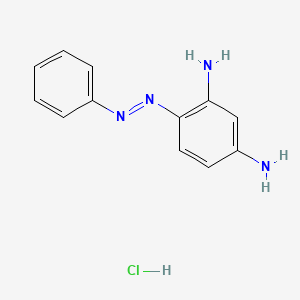D0825 | c.i. basic orange 2
| Toxicity | Dose | Time | Species | Model | Method | Action | Positive criterion | Reference |
|---|---|---|---|---|---|---|---|---|
| MEMBRANE POTENTIAL | 7.53±5.61 | human | qHTS-HepG2 | MMP assay | decrease | IC50 | 163 | |
| MEMBRANE POTENTIAL | 19.95 | human | HepG2 | MMP assay | decrease | IC50 | 163 | |
| MEMBRANE POTENTIAL | 24.91±21.08 | rat | hepatocytes | MMP assay | decrease | IC50 | 163 | |
| Pictogram | Signal | Statements | Precautionary Statement Codes |
|---|---|---|---|
    |
Danger |
Aggregated GHS information provided by 54 companies from 2 notifications to the ECHA C&L Inventory. Each notification may be associated with multiple companies. H302 (100%): Harmful if swallowed [Warning Acute toxicity, oral] H315 (100%): Causes skin irritation [Warning Skin corrosion/irritation] H318 (100%): Causes serious eye damage [Danger Serious eye damage/eye irritation] H341 (100%): Suspected of causing genetic defects [Warning Germ cell mutagenicity] H400 (100%): Very toxic to aquatic life [Warning Hazardous to the aquatic environment, acute hazard] H410 (100%): Very toxic to aquatic life with long lasting effects [Warning Hazardous to the aquatic environment, long-term hazard] Information may vary between notifications depending on impurities, additives, and other factors. The percentage value in parenthesis indicates the notified classification ratio from companies that provide hazard codes. Only hazard codes with percentage values above 10% are shown. |
P201, P202, P264, P270, P273, P280, P281, P301+P312, P302+P352, P305+P351+P338, P308+P313, P310, P321, P330, P332+P313, P362, P391, P405, and P501; (The corresponding statement to each P-code can be found at the GHS Classification page.) |
    |
Danger |
H302: Harmful if swallowed [Warning Acute toxicity, oral] H315: Causes skin irritation [Warning Skin corrosion/irritation] H317: May cause an allergic skin reaction [Warning Sensitization, Skin] H318: Causes serious eye damage [Danger Serious eye damage/eye irritation] H341: Suspected of causing genetic defects [Warning Germ cell mutagenicity] H351: Suspected of causing cancer [Warning Carcinogenicity] H410: Very toxic to aquatic life with long lasting effects [Warning Hazardous to the aquatic environment, long-term hazard] |
P201, P202, P261, P264, P270, P272, P273, P280, P281, P301+P312, P302+P352, P305+P351+P338, P308+P313, P310, P321, P330, P332+P313, P333+P313, P362, P363, P391, P405, and P501; (The corresponding statement to each P-code can be found at the GHS Classification page.) |
| (E)-4-(phenyldiazenyl)benzene-1,3-diamine hydrochloride | 1, 4-(phenylazo)-, monohydrochloride | 1,3-Benzenediamine, 4-(2-phenyldiazenyl)-, hydrochloride (1:1) |
| 1,3-Benzenediamine, 4-(phenylazo)-, monohydrochloride | 2,4-DIAMINOAZOBENZENEHYDROCHLORIDE | 2,4-Diamino azo benzene hydrochloride |
| 2,4-Diaminoazobenzene hydrochloride | 2431787HMZ | 4-(Phenylazo)-1,3-benzenediamine monohydrochloride |
| 4-(Phenylazo)-1,3-benzenediamine, monohydrochloride | 4-(Phenylazo)-1,3-phenylenediamine, monohydrochloride | 4-(Phenylazo)-m-phenylenediamine hydrochloride |
| 4-(Phenylazo)-m-phenylenediamine monohydrochloride | 4-(Phenylazo)-m-phenylenediamine, monohydrochloride | 4-(Phenyldiazenyl)benzene-1,3-diamine--hydrogen chloride (1/1); |
| 4-(phenyldiazenyl)benzene-1,3-diamine, chloride | 4-Phenylazo-m-phenylenediamine hydrochloride | 4-Phenylazo-m-phenylenediamine monohydrochloride |
| 4-Phenylazophenylene-1,3-diamine monohydrochloride | 4-[(Z)-phenyldiazenyl]benzene-1,3-diamine hydrochloride | 4-phenyldiazenylbenzene-1,3-diamine,hydrochloride |
| 532-82-1 | AC-19100 | AKOS015903185 |
| AKOS024319209 | Astra Chrysoidine R | Atlantic Chrysoidine Y |
| Basic Orange 2 | Basic Orange:Chrysoidine Crystals, 1.3-Benzenediamine, 4-(phenylazo), monohydrochloride | Basonyl Orange 200 |
| Brasilazina Orange Y | Brilliant Oil Orange Y Base | C.I. 11270 |
| C.I. Basic Oange 2 | C.I. Basic Orange 2 | C.I. Basic Orange 2, monohydrochloride |
| C.I. Basic Orange 2, monohydrochloride (8CI) | C.I. Basic Orange 3 | C19369 |
| CAS-532-82-1 | CCRIS 162 | CHEBI:82424 |
| CHEMBL1524085 | CHEMBL1682185 | CI 11270 |
| Calcozine Chrysoidine Y | Calcozine Orange YS | Chrysoidin |
| Chrysoidin FB | Chrysoidin Y | Chrysoidin YN |
| Chrysoidin, pure | Chrysoidine | Chrysoidine (II) |
| Chrysoidine A | Chrysoidine B | Chrysoidine C crystals |
| Chrysoidine Crystals | Chrysoidine G | Chrysoidine G (C.I. 11270) |
| Chrysoidine G, analytical standard | Chrysoidine G, for microscopy (Bact., Bot., Vit.) | Chrysoidine GN |
| Chrysoidine GS | Chrysoidine HR | Chrysoidine J |
| Chrysoidine M | Chrysoidine Orange | Chrysoidine PRL |
| Chrysoidine PRR | Chrysoidine SL | Chrysoidine SS |
| Chrysoidine Y | Chrysoidine Y Crystals | Chrysoidine Y Special |
| Chrysoidine Y ex | Chrysoidine YL | Chrysoidine YN |
| Chrysoidine hydrochloride | Chrysoidine special (biological stain and indicator) | Chrysoidine ygh |
| Chrysoidine(II) | Chryzoidyna F.B. | Chryzoidyna F.B. [Polish] |
| DSSTox_CID_4559 | DSSTox_GSID_24559 | DSSTox_RID_77452 |
| DTXSID0024559 | Diazocard Chrysoidine G | EINECS 208-545-8 |
| Elcozine chrysoidine Y | FT-0623812 | HSDB 5491 |
| LS-194 | Leather Orange HR | MCTQNEBFZMBRSQ-UHFFFAOYSA-N |
| MCULE-1639351725 | MFCD00012976 | NCGC00090857-01 |
| NCGC00260035-01 | NSC 152834 | NSC-152834 |
| NSC152834 | Nippon Kagaku Chrysoidine | Pure Chrysoidine YBH |
| Pure chrysoidine yd | Pyracryl Orange Y | Q17522036 |
| SBB058228 | SCHEMBL136697 | ST50410030 |
| Sugai Chrysoidine | T297 | TR-018844 |
| Tertrophene Brown CG | Tox21_202486 | UNII-2431787HMZ |
| Verona Chrysoidine GN | W-105756 | WLN: ZR CZ DNUNR &GH |
| m-Phenylenediamine, 4-(phenylazo)-, hydrochloride | m-Phenylenediamine, 4-(phenylazo)-, monohydrochloride | m-Phenylenediamine, hydrochloride |
| CAS Number | 532-82-1 |
| PubChem Compound | 10771 |

